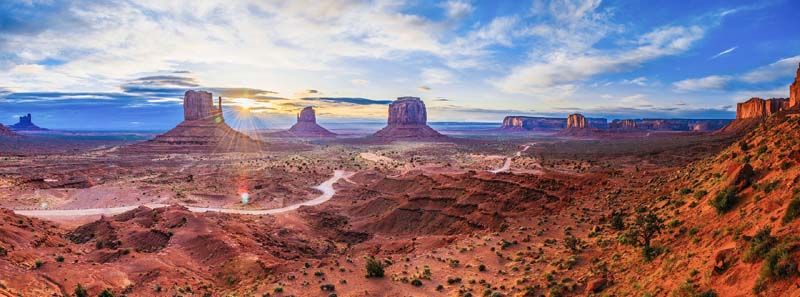
Straddling the red state borders of Arizona and Utah is yet another panoramic landscape of the Southwest — Monument Valley. This iconic Navajo Nation site is less than 200 miles northeast of the Grand Canyon; it comprises 50 square miles of variegated desert colors and distinctive red sandstone mesas and buttes. The tribal name for Monument Valley is Tse’ Bii’ Ndzisgaii, which means “valley of the rocks.” Geographically, Monument Valley Navajo Tribal Park is just a small portion of the wondrous scenery located on the 25,000-square-mile Navajo Indian Reservation. Beginning July 11, 1958, the park was designed as the first tribally owned and operated facility by the Navajo Tribal Council, now called the Navajo National Council.
The Utah/Arizona state line passes through many of the valley’s recognized landmarks, located near Goulding, a small settlement established in 1923 as a trading post. Today, that tribal village provides basic services for tourists (food, lodging, guided tours, and backcountry permits). For many travelers, Monument Valley defines the traditional image of the untamed American Southwest. Starting as far back as the 1930s, the valley was often used as a backdrop for Western film productions. Although that film genre no longer dominates the entertainment field, Monument Valley does remain a dominant venue for commercial photographers and advertising ventures worldwide. In fact, the area is one of the most photographed points on Earth.
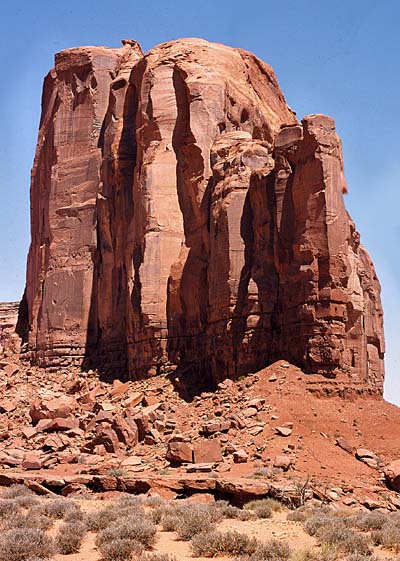 How Did It All Begin?
How Did It All Begin?
Monument Valley is not an actual valley in the standard sense; it’s more of a wide, lowland basin splattered with delicate limestone and sandstone formations towering hundreds of feet. The sights you see today began their foundation within an ancient mountain range that was created 300 million years ago, and then slowly eroded away. The larger remnants from that older range were reformed into the Rocky Mountains during intense plate tectonic activity (major vertical or horizontal movements of Earth’s crust). Meanwhile, in the Southwest, sediments from the eroded materials bonded together in layers forming solid rock, primarily limestone and sandstone. So what occurred next over millions of years?
Navajo Tribal Park guides explain that a slow and gentle uplift generated by pressure from below Earth’s surface elevated the horizontal rock strata in a uniform manner. How high? Estimates range from one to three miles above sea level. Monument Valley’s documented elevation is more than 5,560 feet above sea level. Regardless of stated elevations, what was once a flatland became a plateau! Then for the last 50 million years, natural forces of wind and water cut into and peeled away the surface of the plateau. The simple eroding of alternating layers of soft and hard rock surfaces gradually revealed the current natural formations in Monument Valley.
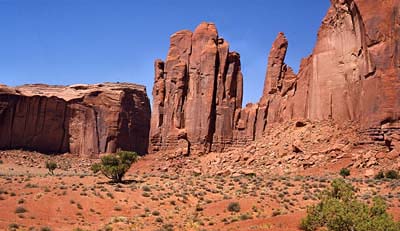 What You Can Experience in Monument Valley
What You Can Experience in Monument Valley
Getting to Monument Valley is relatively easy. In northern Arizona from Flagstaff, you head east on Interstate 40 to U.S. Hwy. 89 and then travel north to U.S. Hwy. 160. From there, you travel east on U.S. Hwy. 160 to U.S. Hwy. 163 (Kayenta exit) and proceed north to the valley. If you are traveling from Utah, you simply head south on U.S. Hwy. 163 from Mexican Hat. This southern approach from Utah offers tourists a wide kaleidoscope view of Monument Valley at Monument Pass; nearby side roads off the main highway lead to the trading post settlements at Goulding and Oljato.
Opposite the turnoff to Goulding from U.S. Hwy. 163 lies the entrance to Monument Valley Navajo Tribal Park. A four-mile road leads east from the highway to the park’s visitor center and Lookout Point. From there, you can observe three of the valley’s most photographed sites: East and West Mitten Buttes and Merrick Butte. The visitor center has year-round restroom facilities and a small convenience store. And during the summer months, Haskenneini Restaurant is a favored venue, specializing in both native Navajo and American cuisines.
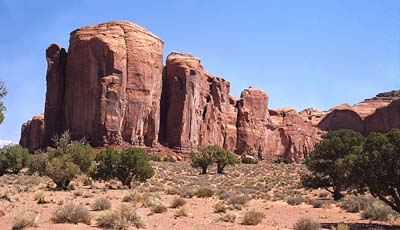 Visitors to the valley have a number of options in planning a memorable experience. Self-drive tours are the most popular, but there’s no shortage of local Navajo guides, either, to take you on narrated tours of the valley. Some unique areas, such as Ear of the Wind, can only be accessed via these guided tours. Other visitors enjoy horseback riding or viewing the scenery from a hot-air balloon.
Visitors to the valley have a number of options in planning a memorable experience. Self-drive tours are the most popular, but there’s no shortage of local Navajo guides, either, to take you on narrated tours of the valley. Some unique areas, such as Ear of the Wind, can only be accessed via these guided tours. Other visitors enjoy horseback riding or viewing the scenery from a hot-air balloon.
Other points of interest from the visitor center include: Mitchell Butte, Gray Whiskers, Big Indian, Castle Butte, Bear and Rabbit, Stagecoach, The King on His Throne, Brigham’s Tomb, The Setting Hen, Sentinel Mesa, and Eagle Mesa.
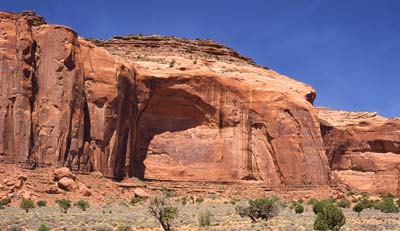 Valley Drive: The Perfect Opportunity for Sightseeing
Valley Drive: The Perfect Opportunity for Sightseeing
Without question, beyond the Lookout Point perspective, most of Navajo Tribal Park’s grandeur can only be witnessed via the Valley Drive. This 17-mile unpaved (dirt) road starts just south of the visitor center and loops around towering spires, mesas, and buttes. This scenic drive takes about two hours to fully appreciate the visual and intrinsic value of the rock formations. The road is dusty and uneven, and steep in some places, but it can be navigated using most conventional vehicles; low-clearance vehicles or those longer than 21 feet should avoid the terrain. Extreme weather conditions, such as heavy rains or seasonal monsoon winds, can make roads impassable or hiking trails very difficult.
On the valley road, you will see 11 numbered signposts to your right, which correspond to the most scenic sights highlighted on the park map, available at the visitor center. Please remember, you must stay on the valley road and not hike closer toward the formations, unless accompanied by a Navajo guide. The one exception is the Wildcat Trail, a self-guided three-mile hiking trail along the West Mitten Butte. Even with minor restrictions, though, the Valley Drive is still a relaxing journey!
Our next post will briefly describe the scenes encountered on the Valley Drive, in addition to citing admission costs and general rules of etiquette for visitors to Monument Valley Navajo Tribal Park.